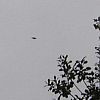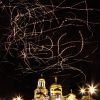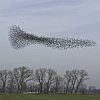Not only rare natural phenomena and unusual man-made contraptions can cause a UFO/UAP report. Often it is a very common object that is mistaken for something it is not. Birds are a fine example of this. We found no less than four ways in which our feathered companions can create confusion.
When a bird accidentally crosses the field of view of a camera for example, photographers often are surprised when they discover the frozen, sometimes blurred image of the bird on the photo afterwards. Many UFO groups who receive such pictures either endorse the strangeness of such shots or - almost equally disturbing - leave it to the viewer to decide whether the document in question shows a genuine UFO or not. We take a clear stand on this : an object that shows up in a photograph but was not seen when the picture was taken, either was not there (we are dealing with a photographic artefact) or was so common that nobody paid attention to it. This common object may then have been an insect, a leaf, a plastic bag or a piece of paper carried by the wind, but in most instances such a picture shows a bird that happened to pass in front of the camera at the moment the shutter-release button was pressed. The aspect of a bird on a photographic image can range from a sharply outlined, disc-like object (when the shutter-speed is high) to a blurred streak (when a low shutter-speed is used). Sometimes the movement of the wings, the speed of the bird, or the angle under which it is photographed, can create a more complex image with fuzzy edges, deforming the animal beyond recognition.
But also at night birds can cause confusion. When unshielded ground lights illuminate the white bellies of seagulls, ducks or plovers, it will make the birds look like a formation of luminous dots, usually arranged in a V-shape. Sky watchers (people who spend hours scrutinizing the sky for rare, natural or unnatural events) are often confronted with formations of strange lights. In many cases the observers had the impression that the objects were self-luminous and flying at a high altitude, until the lights got closer and the beating of the wings revealed their true nature.
In autumn, usually from one hour before to one hour after sunset, a fairy-like spectacle sometimes unfolds in the evening sky : black, round, oval or worm-like clouds can be seen sweeping over country sides and city parks, usually moving in circles. From close by, it becomes clear that these amoeba-like clouds are made up of hundreds, sometimes billions of small birds : the European or common starling (sturnus vulgaris). The birds flock together and glide over the landscape in search for a sleeping place. Often, these "starling clouds" maintain a ball or oval shape, but when predators (like the falcon) approach, the clouds will split up in different smaller clouds, only to be joined together again when the predators are at a safe distance. We believe that these magnificent displays are responsible for some of the strangest sightings on record, in particular for those cases in which so-called "shape-shifting UFOs" were reported.
And finally, there exists a series of articles (mostly from the early 20th century) that link reports of strange, solitary lights darting over fields and pastures, to luminous owls. Especially large barn owls (tyto alba) have been pointed at as the cause of some frightening nocturnal encounters with ghost-like lights (although the early reports emanated mostly from Norfolk, UK, reports have been published in other European countries as well). Where the owls get their luminous qualities from is still uncertain. The generally accepted explanation is that they rub their wings against fungi that harbours phosphorescent bacteria and grows in the hollow trunks where the birds often rest. Other theories attribute the luminosity of the birds to "dampness and uncleanliness of the covering of the breast that had favoured a sudden growth of luminous fungi peculiar to feathers" (Knowledge, September 1913, p. 322) or to "dermal organs of luminescence similar to those found in other animals capable of making light", a bit like a giant firefly you could say. It is believed that luminous or luminescent owls can also account for some reports of Will o' the Wisps (ignis fatuus), a phenomenon which, oddly enough, seems to have disappeared completely in recent decades. Sceptic researchers such as Joe NICKELL (articles at www.csicop.org 2006-06 and www.csicop.org 2000-11) and the late Renaud LECLET (article at francine.cordier.club.fr) have demonstrated convincingly that owls may even have been responsible for a number of much publicized "close encounters of the third kind" involving animal-like UFO creatures.



















